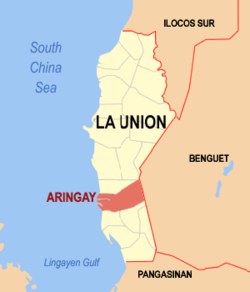Aringay
Aringay | |
|---|---|
Municipalidad | |
 | |
 Mapa de La Union con Aringay resaltado | |
 | |
| Coordenadas: 16°23'53.55"N, 120°21'19.73"E | |
| Nación | Filipinas |
| Región | Región de Ilocos (Región I) |
| Provincia | La Union |
| Número de barangay | 24 |
| Fundación | 1641 |
| Gobierno | |
| • Type | consejo municipal |
| • Electorado | Error en la secuencia de órdenes: la función «getValue» no existe. votantes (9 Mayo 2022) |
| Superficie | |
| • Total | 84,54 km2 (32,64 sq mi) |
| Elevation | 38 m (125 ft) |
| Populación (1 Mayo 2020) | |
| • Total | 50,380 |
| • Densidad | 0,60/km2 (1,5/sq mi) |
| • Hogares | 12,237 |
| Economía | |
| • Clase de ingresos | el segunda clase de municipalidad |
| • Incidencia de la pobreza | Error en la secuencia de órdenes: la función «getValue» no existe.% (Error: fecha y hora no válidas.)[2] |
| • Ingresos | ₱ <strong4a4df3e5">Error (Error: fecha y hora no válidas.) |
| • Activos | ₱ <strong4a4df3e5">Error (Error: fecha y hora no válidas.) |
| • Pasivos | ₱ <strong4a4df3e5">Error (Error: fecha y hora no válidas.) |
| • Gastos | ₱ <strong4a4df3e5">Error (Error: fecha y hora no válidas.) |
| Huso horario | UTC+8 (PST) |
| Código postal | 2503 |
| PSGC | |
| Código telefonico | 72 |
| Lenguaje nativo | ilocano pangasinense Tagalog |
| Website | http://www.aringay.gov.ph/ |
Aringay el segunda clase de municipalidad na provincia de La Union, Filipinas. Tiene este zona de 84.54 kilometro cuadrado.
Comporme del 1 Mayo 2020 censo este tiene papulidad de 50,380 personas y 12,237 hogares. El designada codigo postal 2503 y PSGC 013302000.
Barangay
revisa
|
|
Demografía
revisa| Año | Populación | ±% p.a. |
|---|---|---|
| 1903 | 8572 | — |
| 1918 | 11 247 | +1.83% |
| 1939 | 12 487 | +0.50% |
| 1948 | 13 079 | +0.52% |
| 1960 | 17 572 | +2.49% |
| 1970 | 21 835 | +2.19% |
| 1975 | 25 042 | +2.79% |
| 1980 | 27 524 | +1.91% |
| 1990 | 33 258 | +1.91% |
| 1995 | 36 743 | +1.88% |
| 2000 | 41 422 | +2.60% |
| 2007 | 43 438 | +0.66% |
| 2010 | 44 949 | +1.25% |
| 2015 | 47 458 | +1.04% |
| 2020 | 50 380 | +1.18% |
| Ref: Autoridad de Estadísticas de Filipinas[3][4][5][6] | ||
Referencias
revisa- ↑ «Province: La Union». PSGC Interactive. Quezon City, Philippines: Philippine Statistics Authority. Consultado el Diciembre 17, 2016.
- ↑ «PSA Releases the 2021 City and Municipal Level Poverty Estimates» (2 Abril 2024).
- ↑ Census of Population (2015). "Region I (Ilocos Region)". Total Population by Province, City, Municipality and Barangay. Philippine Statistics Authority.
- ↑ Census of Population and Housing (2010). "Region I (Ilocos Region)". Total Population by Province, City, Municipality and Barangay. NSO.
- ↑ Censuses of Population (1903–2007). "Region I (Ilocos Region)". Table 1. Population Enumerated in Various Censuses by Province/Highly Urbanized City: 1903 to 2007. NSO.
- ↑ «Province of La Union». Municipality Population Data. Local Water Utilities Administration Research Division. Consultado el Diciembre 17, 2016.
